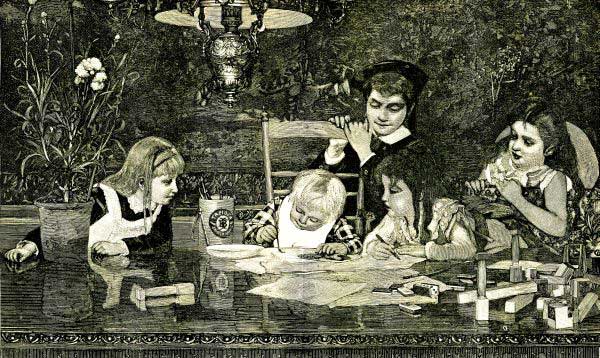The November 11, 1879 issue of Harper’s Young People, a nineteenth century children’s magazine, included in its contents a very short story called The Little Genius. The story starred a five-yearold boy named Bertie and his brothers and sisters. Bertie loved drawing, so his older siblings gave him materials. His siblings found that he wasted their paints, pencils, and papers, so they came up with an ingenious solution to indulge his hobby while preserving their materials for more effective use.
In this article, you will find the original story and illustration that accompanied it along with my brief commentary.
The Original Story and Illustration
Below, you will find The Little Genius with its original illustration, as it appeared in Harper’s.
“The Little Genius” (Re-printed)

Little five-year-old Bertie was very fond of sitting at the study table with his brothers and sisters, especially when they were doing their drawing lessons. But he was not satisfied with watching them. He too wanted to draw and paint, and the older children, who were very fond of him, were always glad to indulge him by lending him their brushes, paints, and pencils. But they soon found that he was very wasteful of their materials, and would use up colors and paper faster than they could be supplied. At last they thought of a better plan. As Bertie was too young to draw nicely, they bought him some wonderful picture-books, all in outline, a box of cheap water-colors, and some brushes. Then Bertie was happy. He would sit for hours painting the pictures in Jack the Giant-killer, Mother Goose, and other story-books for little folks. When he had finished all his little books his mamma brought out some old papers which she had saved, and cutting out the nice pictures, gave them to him to paint. This he did very beautifully. Sometimes he would make funny mistakes, putting green on the horses, and blue on the little dogs and pussy-cats, but this did not happen often. In a little while he had so many nice things painted that his sisters made him a big scrap-book to keep them in, to look at when he grows up.
Bertie may not become a great artist, but his sisters evidently regard him as a little genius.
A Brief Analysis
Bertie’s siblings loved him dearly. It was for that reason that they happily lent him their drawing materials when he was desirous of them. They encountered a problem in that Bertie – who was five and by no means a prodigious artistic talent – wasted their paints, pencils, and papers.
Here, Bertie’s siblings could have declined to share their drawing materials with him due to the fact that they could make far better use of them. Instead, they considered the situation and thought of a way that Bertie could enjoy art without waste. Bertie’s siblings provided him with coloring books (referred to as “picture books” in Harper’s). These coloring books gave Bertie structure, forcing him to confine his coloring within the lines of the figures in the books, but giving him the joy of painting and drawing like the older siblings he admired.
Bertie’s joy was not Bertie’s alone. His doting sisters, no longer concerned that Bertie would deplete their own drawing supplies, saved Bertie’s colorings and collected them in a scrapbook that he would be able to enjoy when he grew older. Harper’s conceded that Bertie was unlikely to become a great artist, but it noted that this mattered not to his sisters, who “evidently regard[ed] him as a little genius.”
It is perhaps ironic that the most ingenious thing in the story was Bertie’s sisters figuring out how Bertie could enjoy drawing without endangering their own supplies.